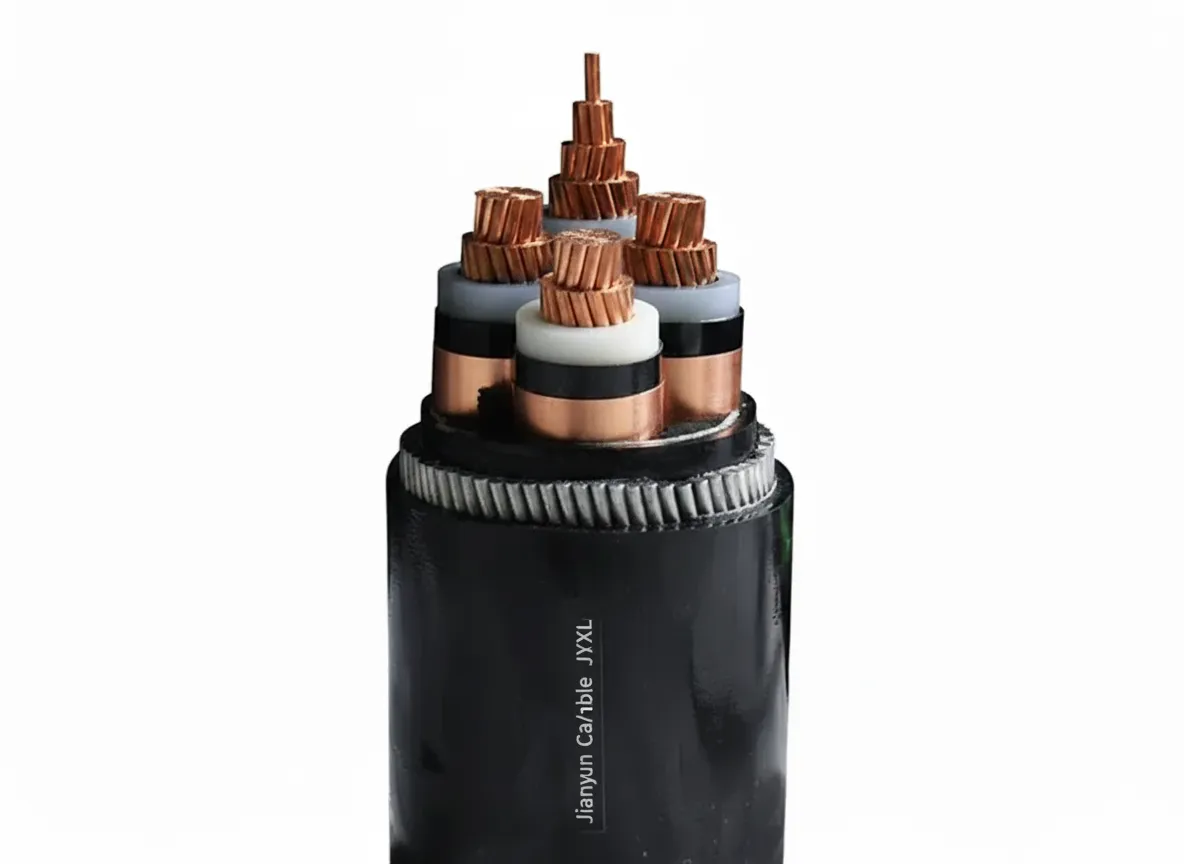Why XLPE Medium Voltage Cables Are Becoming the Industry Standard
Cross-linked polyethylene (XLPE) insulation has emerged as the preferred material for medium voltage (MV) power cables, rated from 6 kV to 35 kV per IEC 60038, due to its superior electrical, thermal, and mechanical properties. XLPE cables are increasingly adopted in industrial, utility, and infrastructure projects, surpassing traditional materials like PVC or paper-insulated cables.

Table of Contents
1. Overview of XLPE MV Cables
XLPE (cross-linked polyethylene) insulation is a thermoset material formed by cross-linking polyethylene molecules, enhancing its thermal and electrical properties. XLPE MV cables, compliant with IEC 60502-2, are designed for voltages from 6/10 kV to 18/30 kV, featuring copper or aluminum conductors, XLPE insulation, copper shielding, and optional steel wire armoring (SWA). They are ideal for applications requiring high reliability and efficiency. Jianyun Cable offers TUV- and CCC-certified XLPE MV cables, ensuring compliance and performance for global projects.
2. Key Advantages of XLPE MV Cables
XLPE insulation offers several advantages that make it the industry standard for MV cables:
- High Thermal Resistance: Operates at 90°C continuously (vs. 70°C for PVC), allowing higher current capacity (e.g., 200 A for 50 mm² copper at 11 kV).
- Excellent Electrical Properties: High dielectric strength (≥20 kV/mm) and low partial discharge (<10 pC), reducing breakdown risks.
- Moisture and Chemical Resistance: Inherently resistant to water treeing and chemicals, ideal for underground or industrial environments.
- Long Lifespan: 25–30 years due to thermal stability and low degradation.
- Environmental Compliance: Can be paired with LSZH sheathing for low smoke/toxicity per IEC 60754-1.
- Example: Jianyun Cable’s 12/20 kV XLPE-insulated MV cable supports high current with minimal losses.
| Advantage | Details |
|---|---|
| Thermal Resistance | 90°C continuous, 250°C short-circuit |
| Electrical Properties | ≥20 kV/mm, <10 pC PD |
| Moisture Resistance | Resists water treeing |
| Lifespan | 25–30 years |
| Environmental | LSZH options for safety |
3. Comparison with Other Insulation Materials
XLPE outperforms traditional materials like PVC or paper-insulated cables:
| Feature | XLPE | PVC | Paper-Insulated |
|---|---|---|---|
| Max Temperature | 90°C | 70°C | 60–70°C |
| Dielectric Strength | ≥20 kV/mm | ~15–20 kV/mm | 10–15 kV/mm |
| Moisture Resistance | High | Moderate | Low (requires oil impregnation) |
| Cost | Moderate | Low | High |
| Lifespan | 25–30 years | 20–25 years | 15–20 years |
| Example | Jianyun Cable’s XLPE MV cable | PVC-insulated cable | Oil-impregnated paper cable |
4. Applications of XLPE MV Cables
XLPE MV cables are used in a wide range of applications due to their versatility:
- Industrial Plants: Powering heavy machinery (e.g., 6/10 kV XLPE cables for manufacturing).
- Utility Grids: Distribution networks (e.g., 12/20 kV for urban substations).
- Renewable Energy: Solar/wind farms (e.g., 18/30 kV for grid integration).
- Infrastructure: Airports, data centers (e.g., 8.7/15 kV LSZH-XLPE for fire safety).
- Example: Jianyun Cable’s 33 kV XLPE-insulated cable for renewable energy projects.
5. Market Trends and Adoption
XLPE MV cables are becoming the standard due to market trends:
- Growth in Renewables: Increasing solar/wind projects require durable MV cables (e.g., XLPE for 90°C operation).
- Smart Grid Integration: XLPE’s low partial discharge supports reliable smart grid systems.
- Sustainability: Shift to LSZH-XLPE for low environmental impact (IEC 60754-1).
- Market Data: MV cable market to grow to USD 76.31 billion by 2032 at 7.81% CAGR, with XLPE holding ~60% share.
- Adoption: 80% of new MV installations use XLPE due to cost-efficiency over paper-insulated cables.
6. Challenges and Solutions
| Challenge | Solution |
|---|---|
| Higher Initial Cost | Consider lifecycle savings (25–30 years); use aluminum-XLPE hybrids. |
| Installation Complexity | Train installers; use Jianyun Cable’s flexible XLPE cables with 6–10D bending radius. |
| Counterfeit Products | Source from Jianyun Cable with TUV/CCC certifications; verify via databases. |
| Environmental Degradation | Use UV-resistant sheathing; apply anti-corrosion coatings for armor. |
| Regulatory Compliance | Ensure IEC 60502-2 compliance; request TUV reports. |
7. Conclusion
XLPE medium voltage cables (6–35 kV) are becoming the industry standard due to their superior thermal resistance (90°C), electrical properties (≥20 kV/mm), moisture resistance, and long lifespan (25–30 years), outperforming PVC or paper-insulated alternatives. Market trends like renewable energy growth and smart grids further drive adoption. Henan Province Jianyun Cable Co., Ltd. offers TUV-certified XLPE MV cables, tailored for industrial, utility, and renewable applications. By selecting XLPE cables and addressing challenges through proper installation and compliance, users can achieve efficient, safe power distribution systems for decades.
Source: JianYunCable.
Comments
Post a Comment